Base de données des minéraux luminescents
FLUORITE
Formule chimique: CaF2
Famille: Halogénures
Statut: IMA-GP
Système cristallin : Cubique
Minéral de vitrine: OUI
Noms associés (variétés luminescentes, noms discrédités, synonymes etc.): chlorophane, yttrofluorite, yttrocerite, Tiffany stone, fluorine,
Luminescence:
Couleurs UV longs (365nm): |
Bleu , Blanc bleuté , Blanc jaunâtre (crème) , Jaune pâle , Jaune , Brunatre , Rouge , Rose violacé , Vert , Verdâtre , Violet , Blanc verdâtre , Bleu violet , Jaunâtre , | ||
Intensité OL:Très forte | Fréquence OL: Très souvent | ||
Couleurs UV moyens (320nm): |
Bleu , Vert , | ||
Intensité OM:Moyenne | Fréquence OM:Souvent | ||
Couleurs UV courts (254nm): |
Bleu , Blanc , Blanc bleuté , Blanc jaunâtre (crème) , Jaune pâle , Jaune , Brunatre , Rouge , Vert , Verdâtre , Vert bleu , Violet , Blanc verdâtre , Bleu violet , Jaunâtre , | ||
Intensité OC:Moyenne | Fréquence OC:Souvent | ||
Photo en lumière du jour

FLUORITE;
Blue Circle Cement Quarry, Eastgate, Weardale, North Pennines, County Durham, England, UK
Photo and Copyright:
Middleearthminerals.com
Used with permission of the author
Photo Ondes longues (365nm)

FLUORITE;
Blue Circle Cement Quarry, Eastgate, Weardale, North Pennines, County Durham, England, UK
UVLW, Photo and Copyright:
Middleearthminerals.com
Used with permission of the author
Galerie de photos:
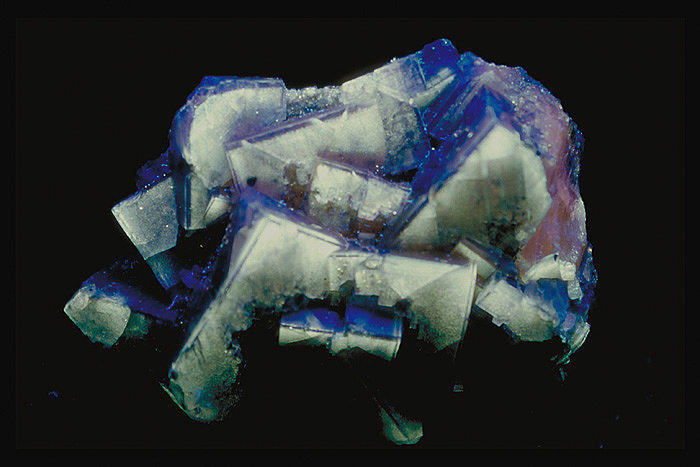

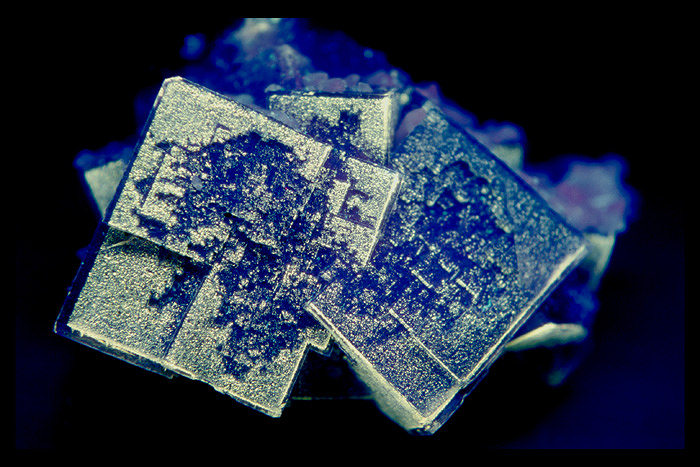
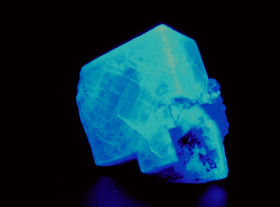 ...
...  Accès à la galerie complète (35 images au total)
Accès à la galerie complète (35 images au total)
Vous avez une photo de ce minéral que vous voudriez voir figurer dans la galerie? Contactez-nous!
Phosphorescence (au sens commun du terme) observable à l'oeil nu:
Type d'UV |
Couleur |
Intensité |
Fréquence d'observation |
|---|---|---|---|
UV longs (365nm): | Blanc verdâtre | Forte | Rarement | UV moyens (320 nm): | Blanc verdâtre | UV courts (254 nm): | Blanc verdâtre | Forte | Rarement |
Triboluminescence: OUI
Thermoluminescence: OUI
Commentaires:
Le minéral luminescent classique par excellence, mais attention, toutes les fluorines ne sont pas luminescente loin de là !
Variété CHLOROPHANE : thermoluminescente en vert ;
Variété YTTROFLUORITE : OC et OL: jaune, blanc jaunâtre (crème);
Activateur(s) et spectre(s):
Activateur(s): Eu2+, ST (Singlet-triplet)-Matière organique en impureté, Sm2+, Ce3+, Sm3+, Eu3+, Dy3+, Ho3+, Er3+, Tb3+, Pr3+, Nd3+, Yb3+, Tm3+,
Pics dans le spectre (nm):
Eu2+ repl. Ca2+: 423-425nm (associated with deep blue-violet fluorescence)
Sm2+ repl. Ca2+: 708, 733nm
Yb2+ repl. Ca2+: 550nm
Dy3+:468, 478, 575, 654, 658, 663, 671, 685nm
Tb3+:482, 484, 486, 492, 539, 543, 544, 546, 583, 588nm
Er3+:519, 522, 528, 551, 554nm
Sm3+:561nm
Eu3+: 574, 595, 618, 622, 700nm
Nd3+: 920nm
M-center(2F+Na+): large pic at 720-745 nm
MA center charge stabilized by O2−–F− : 690 nm
MA center charge stabilized by Na+–Ca2+ : 750nm
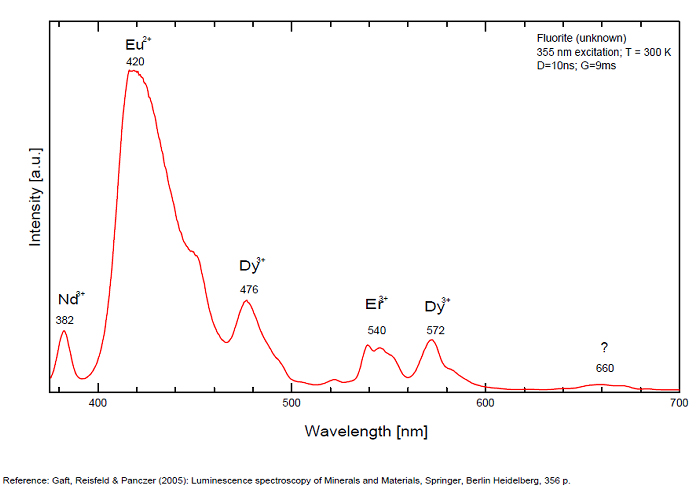
Spectrum: Michael Gaft, Petah Tikva, Israel. Plot: Institute of Mineralogy, University of Vienna, Austria, with permission of the authors.
Galerie de spectres:
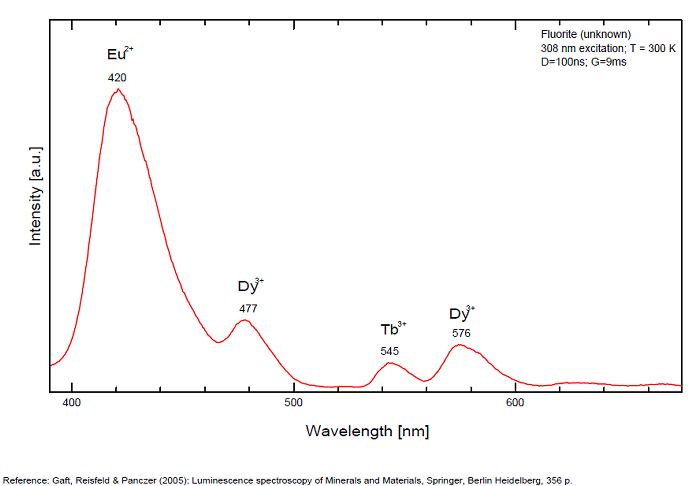
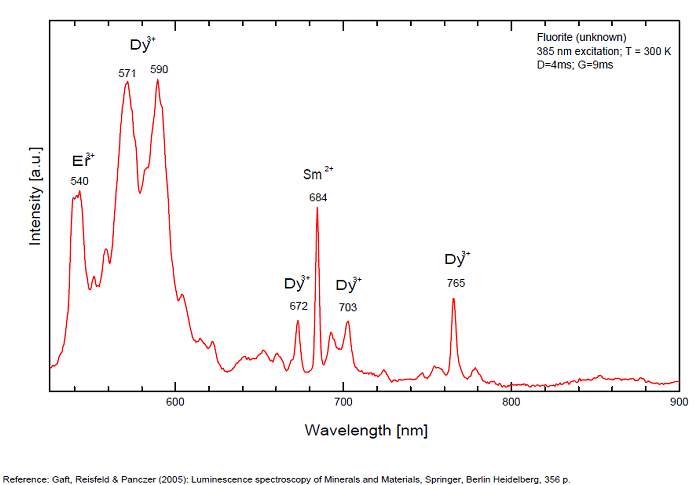
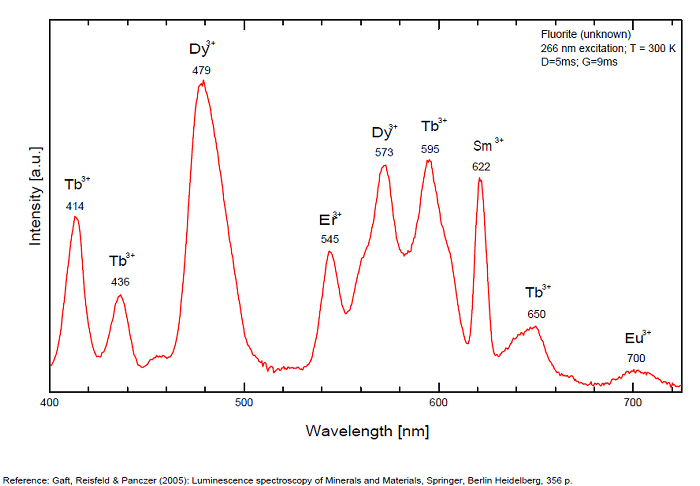
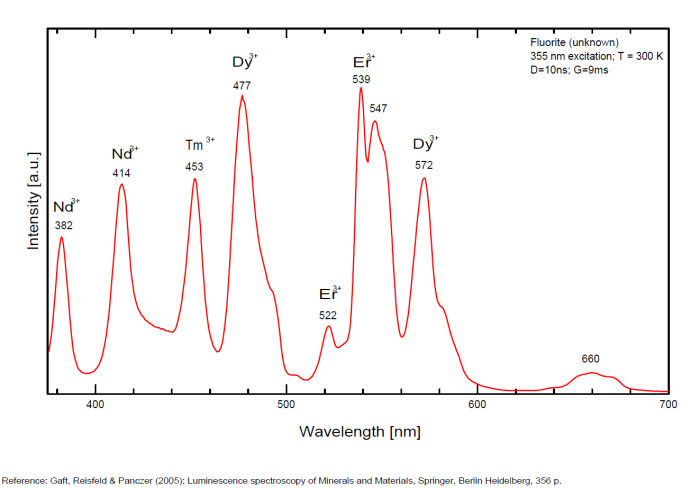 ...
...  Accès à la galerie complète (21 images au total)
Accès à la galerie complète (21 images au total)
Commentaires sur les spectres et les activateurs (*):
Violet fluo associated with Eu2+ (420-423 nm) with peaks at 320 and 340nm (Ce3+), decay time of Eu2+ is 600–800 ns λex = 415 nm is most suitable for measuring the Ho3+ emission beside the Er3+. Fluorite was one of the first mineral substances being investigated by George G. Stokes in 1852, hence the name fluorescence given at the phenomenon. Fluorite is a reservoir for many of the rare earth elements. As early as 1881, it was pointed out that Cerium was present in fluorite. In 1906, Urbain studied the cathodoluminescence of fluorite and ascribed the cause of fluorescence to RRE (Yttrium, praeseodymium, samarium, dysprosium, europium, terbium and also gadolinium and Ytterbium in chlorophane); Morse (1907), Tanaka (1924), Nichols (1928) and F. G. Wick also investigated the cause of luminescence of fluorite. The fusion of fluorescent fluorite (1100-1200°C) changes the spectrum markedly. Often the blue luminescence spectrum is changed to a more orange-red, showing sharp lines typical of RRE. De Ment makes 2 groups in the luminescent fluorites: group 1: single band in the UV at 300nm and 3 bands in the visible at 475, 508 and 578nm Radiation induced MA centers’ charge stabilized by Na+–Ca2+ is responsible of emission at 750nm and O2−–F− at 690 nm) (Tarashchan 1978, Gaft and Al. 2020).
yellow fluo associated with Dy3+;
M-center: large pic at 720 nm;
Lifetime: 2μs ( @420nm);
group 2: two bands in UV at 280 and 300nm and strong peaks at 475, 510, 536, 548 and 578nm in the visible.
(*)Les commentaires sur les spectres sont uniquement rédigés en Anglais
Meilleure(s) localité(s) pour la fluorescence (*):
- Rogerley Mine, Weardale, County Durham, England;
- Alston Moore, England;
- Dalnegorsk, Primorskiy Kray, Russia;
- Seilles, Andenne, Prov. de Namur, Belgium (LW fluo red);
- Hunza Valley, Gilgit District, Pakistan;
- Braldu Valley, Skardu District, Gilgit-Baltistan, Pakistan (green SW+LW+Phospho);
- Yuno, Shigar District, Gilgit-Baltistan, Pakistan (green SW with fluorapatite in quartz and microcline);
- Mapimi, Durango, Mexico (SW dull red, LW red);
- Hammam-Zriba Mine, Zriba-Village, Zaghouan Governorate, Tunisia (buish-white LW);
- Rosiclare, Illinois, USA;
- Clay Center, Ohio, USA (yellow-white LW + phosphorescence);
- Yuma County, Arizona, USA;
- Fourmile Creek Area, Fremont Co., Colorado, USA (LW blue + SW & MW green)
- Berta Mine, El Papiol, Barcelona, Spain;
- Villabona Mine, Llanera, Asturias, Spain;
- Xianghualing Sn-polymetallic ore field, Linwu Co., Chenzhou, Hunan, China (blue + red fluo LW);
- Sanming, Fujian, China (blue LW with temporary red fluorescence disappearing after a few seconds);
- Taourirt, Taourirt Province, Oriental Region, Morocco (temporary LW red fluorescence disappearing after a few seconds and comming back after a few minutes without UV);
- Aouli, Upper Moulouya mining district, Midelt Province, Drâa-Tafilalet Region, Morocco (yellow cubes SW white, LW blue)
- Kharan District, Balochistan, Pakistan (fluo red LW).
(*)Les données ne sont pas exhaustives et sont limitées à quelques localités remarquables pour la fluorescence
Référence bibliographique pour la luminescence:
- The Henkel Glossary of Fluorescent Minerals, Dr. Gerhard Henkel, Published by the FMS, 1989 ,
- Fluorescence: Gems and Minerals Under Ultraviolet Light, Manuel Robbins, 1994, Geoscience Press, ISBN 0-945005-13-X ,
- The World of Fluorescent Minerals, Stuart Schneider, Schiffer Publishing, 2006, ISBN 0-7643-2544-2 ,
- Luminescence Spectroscopy of Minerals and Materials, M. Gaft, R. Reisfeld, G. Panczer, Springer Editor, ISBN: 10 3-540-21918-8 ,
- Luminescent Spectra of Minerals, Boris S. Gorobets and Alexandre A. Rogojine, Moscow, 2002 ,
- Ultraviolet Light and Fluorescent Minerals, Th. Warren, S. Gleason, R. Bostwick, et E. Verbeek, 1995, ISBN 0-9635098-0-2 ,
- Franklin Website: http://franklin-sterlinghill.com ,
- Luminescenza nel regno minerale, Guido Mazzoleni, fotografia Roberto Appiani, Libri Sandit, 2010, ISBN 978-88-95990-63-7 ,
- Handbook of mineralogy, John W. Anthony, Richard A. Bideaux, Kenneth W. Bladh, and Monte C. Nichols, and published by Mineral Da ,
- The Langesundfjord, history, geology, pegmatites, minerals, Bode Edition, 2010, ISBN 978-3-925094-97-2 ,
- Handbook of Fluorescent Gems and Minerals, a practical guide for the gem and mineral collector, Jack de Ment, 1949 ,
Référence pour la luminescence sur internet:
- The Langesundsfjord: history, geology, pegmatites, minerals, Alf Olav Larsen, Bode Verlag Gmbh, 2010 ISBN 978-3-925094-97-2.
- Luminescence properties of Ce3+ and Eu2+ in fluorites and apatites Sabina Bodyl, Mineralogia, 40, No. 1–4: 85–94 (2009)
- Thermoluminescence of Fluorite and Age of Deposition, Frank N. Blanchard, The American Mineralogist, Vol. 51, March-April, 1966
- Luminescence from natural fluorite crystals, Calderon T. , Khanlary M.-R. , Rendell H. M. , Towsend P. D., International journal of radiation applications and instrumentation. Part D. Nuclear tracks and measurements, 1992, vol. 20, no3, pp. 475-485
- Luminescence properties of rare earth ions in fluorite, apatite and scheelite minerals, M. Czaja, S. Bodył, P. Głuchowski, Z. Mazurak and W. Strek, Journal of Alloys and Compounds Volume 451, Issues 1-2, 28 February 2008, Pages 290-292
- The luminescence properties of rare-earth ions in natural fluorite, M. Czaja, S. Bodył-Gajowska, R. Lisiecki, A. Meijerink, Z. Mazurak
- Steady-state Luminescence for qualitative identification of rare-earth ions in minerals, M. Czaja, S. Bodył-Gajowska, Z. Mazurak, 2013, Journal of Mineralogical and Petrological Science
- https://www.mindat.org/article.php/2789/Photoluminescent+Properties+of+the+Fluorites+from+Walworth%2C+New+York
- https://www.mindat.org/article.php/2786/An+Interesting+Fluorite+Occurrence+in+the+Limestone+Capital+of+the+World
- Fourmile Creek Area, Co, USA;
- MONT-SAINT-HILAIRE, History, Geology, Mineralogy, Laszlo HORVATH, The Canadian Mineralogist, Special Publication 14, 2019
- https://www.researchgate.net/publication/345143472_Red_photoluminescence_and_purple_color_of_naturally_irradiated_fluorite
Images:
- Braldu Valley, Skardu District, Gilgit-Baltistan, Pakistan (LW+SW+Phospho): https://www.mindat.org/photo-954531.html
- Yuno, Shigar District, Gilgit-Baltistan, Pakistan (green SW with fluorapatite in quartz and microcline): https://www.mindat.org/photo-629252.html
- Xianghualing Sn-polymetallic ore field, Hunan, China: https://www.mindat.org/photo-933551.html & https://www.mindat.org/photo-933552.html
- Sanming, China (blue LW with temporary red fluorescence disappearing after a few seconds): https://www.mindat.org/photo-932814.html
- Thermoluminescence (Colorado, USA): http://www.mindat.org/photo-291222.html
- Aouli, Morocco: https://www.mindat.org/photo-889701.html
Videos:
- Thermoluminescence:https://www.youtube.com/watch?v=42VGkvXUAvc
- Thermoluminescence (en Français): https://www.youtube.com/watch?v=7bAyKSsLrOQ
- Proton-luminescence et Thermoluminescence of artificial fluorite used in dosimeter: https://www.youtube.com/watch?v=7bAyKSsLrOQ
Référence minéralogique sur internet:
 http://www.mindat.org/show.php?name=Fluorite
http://www.mindat.org/show.php?name=Fluorite
 http://webmineral.com/data/Fluorite.shtml
http://webmineral.com/data/Fluorite.shtml
Recherche sur Internet:
 Recherche d'images sur 'Google Image'
Recherche d'images sur 'Google Image'
 Recherche de documents en français sur Google
Recherche de documents en français sur Google
 Recherche de documents en toutes
langues sur Google
Recherche de documents en toutes
langues sur Google
Une requête ne donnant pas de résultat signifie uniquement qu'aucune référence de ce type n'existe dans la base mais en aucun cas qu'elle n'existe pas dans l'absolu. Si vous considérez avoir trouvé une erreur ou une omission, merci de nous le signaler via la page contact en n'oubliant pas de citer la source de l'information.
